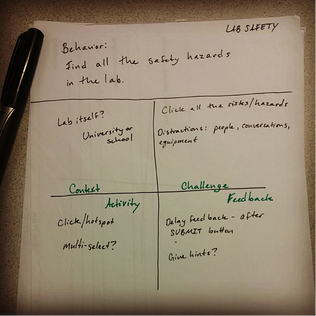Blog
3 Fun Factors to a Successful e-Learning Project Kickoff Meeting
by Ellen Burns-Johnson, instructional writer/designer Do you remember notes? Good, old-fashioned notes, written on paper, and likely ornamented with ...


Effort, Time & Focus: A Recipe For Interactive e-Learning
By Ellen Burns-Johnson | April 07, 2015 | Custom Learning | 0 Comments

by Ellen Burns-Johnson, instructional writer/designer

Do you remember notes? Good, old-fashioned notes, written on paper, and likely ornamented with doodles. Remember those?
I still scribble in my spiraled notebook occasionally, but most of the time I'm a digital note-taker. When I take notes during meetings, I do so on my laptop in OneNote. I list and schedule reminders to do household chores in Google Keep. I bookmark articles using Pocket and Evernote. I rely pretty heavily on these apps to stay organized and focused, and I bet many of you do, too.
So when I came across an article explaining how taking notes in longhand may be better for long-term retention of conceptual information, I was a bit perturbed. Why might this be? Do I need to uninstall my apps and shake my writing hand back into shape?
Learning takes mental effort
The study described in the article, which was posted by the Association for Psychological Science, found that lecture attendees who took notes by hand retained more information than those who took notes on a laptop. The difference in recall was even more pronounced when the information took the form of complex concepts (as compared to simple facts).
One possible reason for the difference is the amount of cognitive effort needed to take notes by hand. It's often tempting or beneficial for note-takers to copy words verbatim from the source. On a laptop, that's easy to do; indeed, notes taken on a laptop often resemble transcripts. Conversely, pen-and-paper note-takers are generally forced to summarize, since few people can write fast enough to keep up with a naturally paced conversation. Summarizing requires more cognitive processing, which in turn helps the brain retain and recall information more effectively.
Speaking purely anecdotally, I think this makes sense. I take more notes using my laptop, but when I write by hand, I do tend to remember more of what I wrote. I summarize and annotate, adding little notes and sketches that help me interpret the information.
Learning takes time
This phrase from the APS' blog post stands out for me:
"The results revealed that while the two types of note-takers performed equally well on questions that involved recalling facts, laptop note-takers performed significantly worse on the conceptual questions."
In business, most of what we need employees to do in business doesn't involve simple fact recall — more frequently, people are asked to remember complex concepts or to develop a particular set of skills. To use familiar language from Bloom's cognitive taxonomy, most learners have jobs that move beyond simple "knowledge" and into comprehension, application, analysis and so forth.
In this way, the results of the note-taking study aren't really surprising. We already know that if learning is to persist long enough to be useful, it will require some time for reflection and consideration.
Yet sometimes it can be very difficult to carve out time for deeper learning. There is a lot of pressure to keep people working at their desks, on the sales floor, or out in the field. It's important that training efforts are focused in the right direction.
Learning takes focus
The more effective note-takers from the study were those who didn't try to capture every bit of information. Similarly, our training shouldn't try to convey every bit of material. It should focus on helping learners become more skilled at important parts of their work.
Here are three ideas for keeping training focused on the right stuff:
1. More practice
2. Quality feedback
3. Performance support
Conclusion
If we want learning to stick, there are no shortcuts. It takes effort, time, and focus. The strategy employed by the pen-and-paper note-takers in the study―to concentrate on the most important material—is one that can serve us well as instructional designers, too.
Want to share this post? Here are some ready-made tweets:
Click to Tweet: A Recipe For Interactive #eLearning "Learning requires effort, time and focus" http://hubs.ly/y0GN4W0 via @customelearning @EllenBJohnson
Click to Tweet: If we want #learning to stick, there are no shortcuts. It takes effort, time, and focus. http://hubs.ly/y0GN4W0 #interactiveelearning

About the Author: Ellen Burns-Johnson
Ellen Burns-Johnson has over a decade of experience in the education and training industries. She has crafted the instructional strategy and design for dozens of major initiatives across diverse topics, from classroom safety to IT sales. Emphasizing collaboration and playfulness in her approach to creating learning experiences, Ellen’s work has earned multiple industry awards for interactivity and game-based design. Ellen is also a Certified Scrum Master® and strives to bring the principles of Agile to life in the L&D field. Whether a client is a Fortune 100 company or a local nonprofit, she believes that the best learning experiences are created through processes built on transparency between sponsors and developers, empirical processes, and respect for learners. Outside of her LXD work, Ellen plays video games (and sometimes makes them) and runs around the Twin Cities with her two mischievous dogs (ask for pictures).
Comments
Would you like to leave a comment?
Related Blog Posts

By: Ellen Burns-Johnson | Feb, 2014
Category: Custom Learning, Strategic Consulting

Blog
Learner-Centered Design: 3 Quick Ideas for e-Learning
by Ellen Burns-Johnson, instructional writer/designer Do you remember notes? Good, old-fashioned notes, written on paper, and likely ornamented with ...
By: Ellen Burns-Johnson | May, 2014
Category: Custom Learning

Blog
Q&A: Three Quick Ideas for Creating Interactive e-Learning
by Ellen Burns-Johnson, instructional writer/designer Do you remember notes? Good, old-fashioned notes, written on paper, and likely ornamented with ...
By: Ellen Burns-Johnson | Apr, 2015
Category: Custom Learning, Strategic Consulting

![[Webinar] Learner-Centered Design: 3 Quick Ideas](https://no-cache.hubspot.com/cta/default/55048/202e8e7e-df49-4237-b2bb-8f18a23e9557.png)
